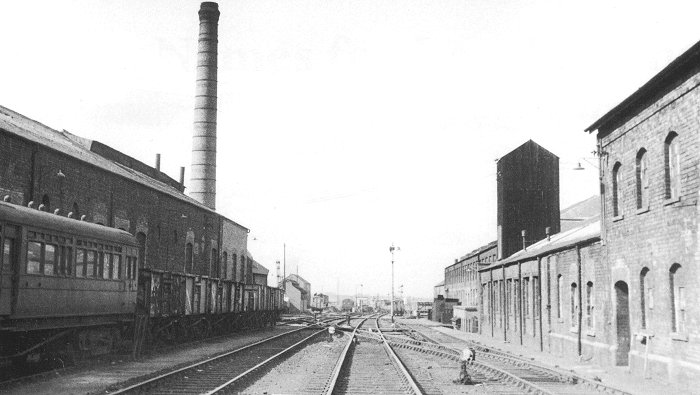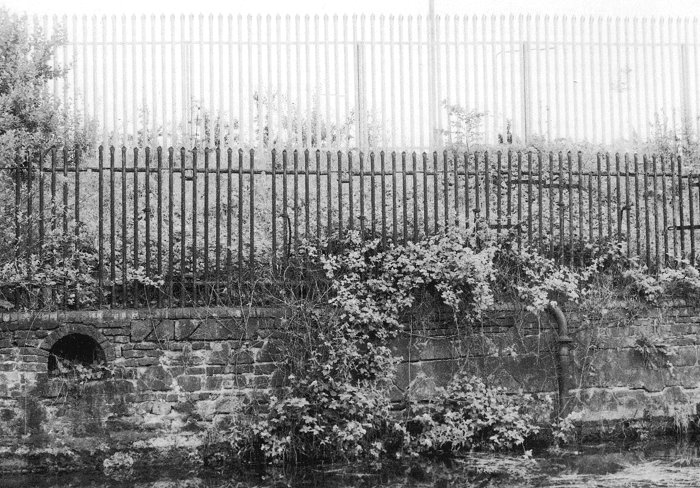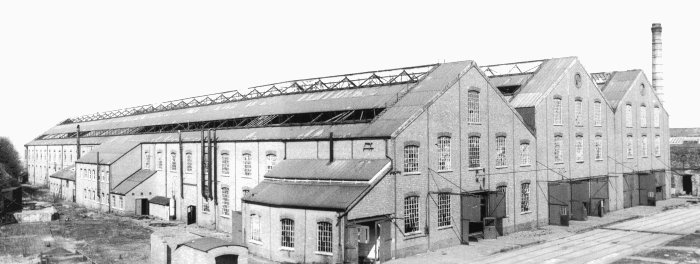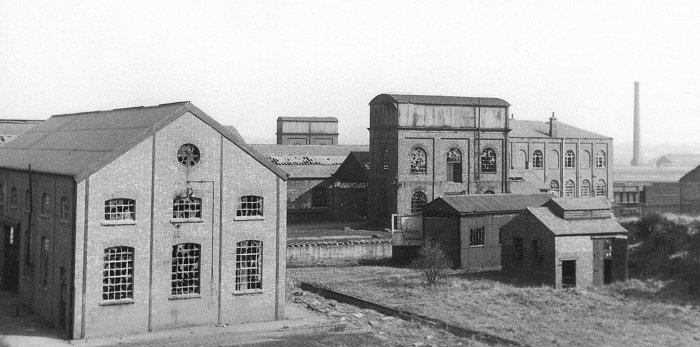
A September 1963 view looking
north through the Works towards Stafford Road Junction
and Oxley viaduct down the line from Victoria Basin
(Herbert Street goods depot by this time). The building
on the right is the carpenters shop, and beyond that is
the old machine shop, with the long taller building
beyond the black tower structure being the boiler shop
that had once been the (High Level) erecting shop. The
1932 repair shop lies to the left, obscured by older
buildings housing the coppersmiths shop and the iron
foundry. Simon Dewey. |
|
Between January 1961 and the
closure of Stafford Road Works in February 1964,
over 590 locomotives had been dealt with, the last
being an ex-Great Western '2800' class 2-8-0, No
2859 from Pontypool Road shed in for a Light/Casual
repair, entering the Works on 16 December 1963 and
being released on 11 February 1964. This locomotive
is still in existence, having been saved from Dai
Woodham's scrapyard at Barry Island, however, it
presently remains in unrestored condition.
Unfortunately no example of an actual Stafford Road
Works-built engine was ever kept for preservation -
a great pity, and sad loss to Wolverhampton's proud
industrial heritage.
Prior to closure, a small
number of BR diesel shunters (Class '08' as
subsequently designated) from Oxley and Tyseley
sheds had been repaired during 1962, and also the
departmental engine PWM 654 had received attention
in 1961, a pale reflection of the long history of
small engine repairs that the Works had always
concentrated on over the years.
As a footnote, it should be
mentioned that for a long time Stafford Road Works
also had a separate thriving industry in producing
various types of medium to heavyweight iron
castings, ranging from chimneys (both locomotive and
building) through to water columns and large
building supports. An example of such a chimney
casting can been seen in the stores section of the
National Railway Museum at York.
Additionally, there was also a separate construction
plant set up alongside the Victoria Basin line.
Known as 'Spike Island', it produced vast amounts of
unclimbable security fencing made up from old boiler
tubes that were no longer usable on the locomotives.
Some remains of this type of tubular fencing can
still be found along the Birmingham Canal
Navigation, which ran close to the lower shed yard
and alongside the shed coaling plant. At one time
these black-tar dipped fence sections could be seen
all around the GWR system, these protecting engine
sheds, goods yards and sidings, etc. A short
footpath leading to an underground passageway
adjacent to the canal was even nicknamed Birdcage
Walk in view of the amount of boiler tube fencing
that could be seen alongside the canal towpath and
above the entrance. |

An example of 'Spike
Island' boiler tube fencing still in place
alongside the canal in 1985. Boiler tubes that
were too old or damaged to be of any further use
in locomotives were sent over from Stafford Road
Works to a separate manufacturing plant located
beside the Victoria Basin line, not far from the
Works. Here these were cut to length, shaped to
a point, and finally dipped in hot tar to
produce a weatherproof coating both inside and
out. Some sections of this fencing still exist,
and they have now been included in the
Wolverhampton Locks Conservation Area Appraisal
issued in May 2013 as being an item of historic
interest. Author. |

A 1969 view from the
high ground at the southern end of the
Stafford Road Works site looking north and
showing the full extent of the 1932 repair
shop, albeit pictured some five years after
closure of the Works. The nearest section
(with the slightly lower gable) had housed
the wheel shop, machine shop, and sundry
stores, and it is the toilet block that
projects out about mid-way down its length.
As already described, the two taller gables
formed the repair shop itself, but it is
worth noting that there was no physical
separation of these sections internally.
With demolition of the site now looming, no
longer would locomotives use the now
redundant traverser to enter the building
through the lofty doors to begin their
overhauls and be revitalised. Simon Dewey. |
|
Following closure,
most of the Works and its shed buildings
were finally demolished during the late
1970s, and the connecting corridor
between the two halves of the Works
actually collapsed of its own volition
into the Stafford Road below. The very
last building to be demolished was the
old lower yard erecting shop, its roof
still supported by Stafford
Road-manufactured cast-iron columns,
having been retained for use as a tyre
storage warehouse following the
clearance of the rest of the site. A
modern trading estate now occupies the
site of the Works and sheds on both
sides of the Stafford Road, with only
occasional fragments of the old brick or
stone retaining wall still in place, so
as to give an indication of the previous
history of the site. A set of stone
approach steps leading up to the old
Great Western Works employees' institute
even lingered on in isolation until
around 1985, although the institute
building itself was by then long gone.
Some time later,
the West Midlands County Council erected
a small cast plaque close to the
junction of Gorsebrook Road and Stafford
Road to commemorate the 150th
anniversary of the Great Western, and
also to recall the fact that the
Stafford Road Works and locomotive sheds
were situated immediately south of
Gorsebrook Road, and that between 1859
and 1908 nearly 800 locomotives had been
built there. The plaque may even still
be there, unless it has been stolen for
its scrap value by metal thieves.
However, the preservation of a
Wolverhampton Stafford Road-built engine
much earlier on would have been a far
better tribute to the Works, with 2-6-2T
No 4519 still being available for
purchase from British Railways up until
October 1963.
References and Acknowledgements
| The Armstrongs of The
Great Western - Harold
Holcroft. |
| An Outline of Great
Western Practice and
Performance 1837 to 1947 -
Harold Holcroft. |
| The Wolverhampton
Railway Gazette - published
by John Bates and Mervyn
Srodzinsky. |
| Rail Centres:
Wolverhampton - Paul
Collins. |
| Brunel's Broad Gauge in
the Black Country - Michael
Hale. |
| The Locomotives of The
Great Western Railway -
published by The RCTS. |
| 'The Wolverhampton
Chronicle' and 'Express &
Star' newspapers. |
| The search engine
facilities at the National
Railway Museum, York. |
In addition, both John Bucknall and
Simon Dewey must also be given due
credit for their invaluable assistance
and photographic input, both in
connection with this and any subsequent
articles with regard to the GWR at
Wolverhampton. The contribution to early
railway history at Wolverhampton, as can
be derived from the photographs taken at
Stafford Road by R.H. Bleasedale, must
also be taken into account as many of
the photographs which are reproduced
here have been taken from some of his
original sepia prints. Finally, thanks
go to Colin Moss with regard to his help
as to diesel working in the
Wolverhampton area in the 1960s. |

Here we see
the buildings at the southern end of
the Works site before their
demolition in 1969. On the left is
the tank shop dating from 1932 with,
centrally, the vehicular entrance to
the Works off the Stafford Road and
the No 2 water tank adjacent, behind
which can be seen the GWR
Enginemen's Institute building. The
water tank in the distance is that
of Stafford Road shed. Simon Dewey. |
 |
|
 |
Return to
part 3 |
|
Return to
the beginning |
|